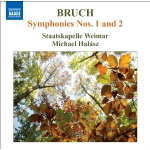Composed soon after his Violin Concerto, Bruch’s Symphony No. 1 is a pleasing and inventive work that follows in the style of Schumann, with a bit of Mendelssohn thrown in. The horn writing in the first movement is of pure German romanticism, and immediately brings to mind Schumann (and even hints at Bruckner), while the swiftly dancing Scherzo contains echoes of Mendelssohn’s lighter movements. The whole piece brims with fetching melodies and engaging vitality.
The same cannot be said for Bruch’s Symphony No. 2. A pernicious heaviness has crept into the composer’s symphonic style. The first movement is a fussy amalgam of Brahms’ Symphony No. 1 and Mendelssohn’s Lobgesang, while the finale’s main theme is rhythmically all-too-similar to Brahms (whose own theme echoed Beethoven’s Ninth). It’s all diligently and cleverly worked out, but the melodic material is distinctly unmemorable, and you feel a sense of relief when it finally ends.
Michael Halász leads a lively performance of Symphony No. 1 with the Staatskapelle Weimar. They do their best with Symphony No. 2, and it helps that Halász keeps things moving and the textures light (especially compared to Masur’s dull rendition). Perhaps a star conductor and a world-class virtuoso orchestra could make No. 2 sound convincing–then again, perhaps not. Naxos’ sound is top-notch. Worth investigating, at least for Symphony No. 1.
































